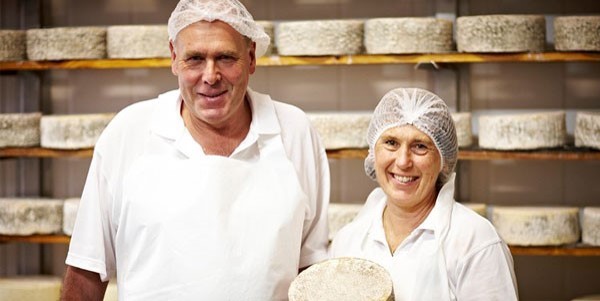Meet the Cheese Makers Melbourne Trusts: The Tradition of Floridia Cheese Thomastown
Meet the Cheese Makers Melbourne Trusts: The Tradition of Floridia Cheese Thomastown
Blog Article
Opening the Tricks of Artisanal Cheese Making: A Step-by-Step Do It Yourself Guide
In the realm of cooking craftsmanship, artisanal cheese making stands as a testament to the delicate equilibrium between tradition and advancement. Each action in the process, from choosing the appropriate milk to improving aging techniques, holds within it a wide range of knowledge gave through generations. As we start this trip to demystify the art of creating elegant cheeses, we are confronted with a tapestry of tricks and skills waiting to be unwinded. Join us as we explore the complexities of this old craft, where art, scientific research, and patience converge to generate flavors that entice the senses.
Picking the Right Milk
When starting the trip of artisanal cheese making, the selection of milk plays a critical duty in figuring out the high quality and features of the end product. The kind of milk chosen influences the flavor, appearance, and generally account of the cheese. Raw milk, right from the animal, is favored by numerous artisanal cheesemakers as a result of its one-of-a-kind mix of enzymes, germs, and flavor compounds. Nonetheless, making use of raw milk comes with threats and laws, making sterilized milk a more secure option for beginners.
When picking milk for cheese production, it is vital to consider the fat content. Higher fat material in milk can result in a creamier and richer cheese, while reduced fat content may lead to a drier and stronger texture. Additionally, the resource of the milk, whether from cows, goats, lamb, or buffalo, contributes unique flavors and attributes to the cheese (Floridia Cheese Melbourne). Each sort of milk brings its very own subtleties, enabling a vast array of cheese selections to be crafted based upon the chosen milk. Inevitably, the selection of milk is a basic decision that sets the foundation for an effective artisanal cheese-making undertaking.
Culturing and Coagulating
To launch the cheese-making process, the vital actions of culturing and coagulating should be carefully performed to change milk into curds and whey. Culturing entails introducing helpful microorganisms to the milk, which then starts the fermentation procedure. These bacteria convert lactose (milk sugar) right into lactic acid, producing the acidic environment needed for coagulation. The type of culture used can considerably impact the flavor, texture, and ripening of the last cheese item.

The timing and temperature level control throughout culturing and coagulation are vital factors that affect the final result of celebrity. Appropriate execution of these actions is important to ensure the desired texture, flavor, and uniformity of the artisanal cheese being produced.
Draining Pipes and Pushing Curds
After the milk healthy proteins have actually coagulated and the curds have actually been cut to release whey, the next important step in artisanal cheese making includes draining pipes and pressing the curds to accomplish the preferred structure and consistency of the final cheese product. The time for draining can differ depending on the kind of cheese being made and the desired dampness content.
When the curds have actually adequately drained pipes, the following step is pushing. Pressing assists remove any remaining whey and compacts the curds to form a strong cheese wheel. Pushing can be done utilizing specialized cheese presses that use consistent and gentle pressure over a time period. The duration and pressure used throughout pressing will affect the final texture of celebrity, from soft and velvety to difficult and firm. Proper draining More Info and pressing are essential actions that substantially affect the high quality and characteristics of the artisanal cheese being produced.
Aging and Flavoring Strategies
Executing meticulous aging and flavor methods This Site is pivotal in enhancing the deepness and intricacy of artisanal cheeses, raising their taste accounts to exquisite degrees of improvement and refinement. Aging plays a critical role in creating the unique tastes and structures that differentiate artisanal cheeses.
Seasoning strategies likewise contribute dramatically to the last taste of artisanal cheeses. Cheesemakers may choose to introduce additional flavors by integrating ingredients such as herbs, flavors, or perhaps fruits into the cheese throughout the manufacturing process. Furthermore, some cheeses are washed or massaged with numerous fluids, such as brine or alcohol, to improve their appearances and flavors.
Wrapping and Keeping Cheeses

Final Thought
To conclude, mastering the art of artisanal cheese making includes meticulously choosing the right milk, complying with precise culturing and coagulating processes, draining pipes and pushing curds properly, and utilizing different aging and flavoring methods. By following these actions carefully and with interest to information, you can create your own scrumptious and unique cheeses at home. Keep in mind to cover and store your cheeses properly to make certain ideal flavor and texture growth. Pleased cheese making!
Each kind of milk brings its very own nuances, enabling for a wide range of cheese selections to be crafted based on the chosen milk.After the milk proteins have actually coagulated and the curds have actually been reduced to release whey, the next important step in artisanal cheese making involves draining pipes and pushing the curds to achieve the wanted structure and consistency of the last cheese item. Many cheeses need to be covered in wax paper or cheese paper to enable them to take a breath while shielding them from drying out. For cheeses that need to continue aging, such as bloomy skins or cleaned skins, guarantee they are kept in an amazing setting like a cheese cave or a refrigerator set to the appropriate temperature. By paying attention to the covering and storage of artisanal cheeses, cheese makers and fanatics can protect the honesty of these specials and fully enjoy their intricate flavors.
Report this page